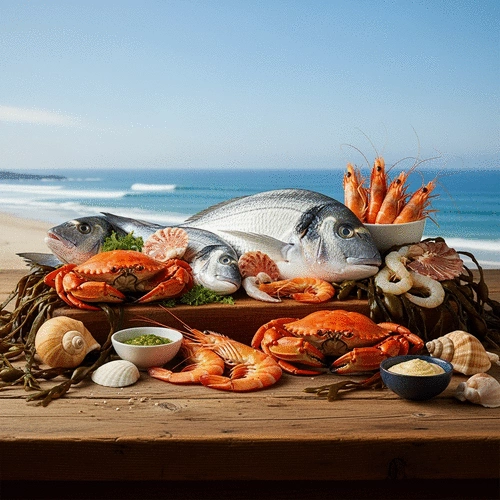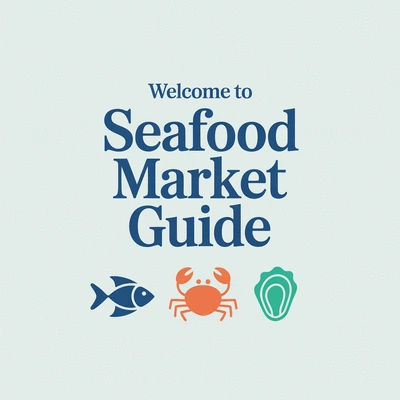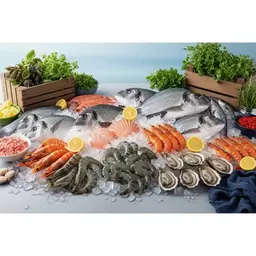Every year, billions of seafood lovers make choices that impact our oceans and communities. What if your seafood decisions could contribute to sustainability and environmental conservation? Embracing seasonal sustainable seafood means not only enjoying rich flavors but also making responsible choices for the health of marine ecosystems.
What You Will Learn
- Understanding the definition of sustainable seafood and its role in promoting marine ecosystem health.
- The significance of seasonal seafood choices for flavor, sustainability, and local community support.
- How to utilize guides and resources like Seafood Watch and the Australian Sustainable Seafood Guide for informed seafood selections.
- Inspirational testimonials from individuals who have successfully integrated seasonal sustainable seafood into their lifestyles.
Understanding Sustainable Seafood Choices and Seasonality
This visual highlights the aspects of sustainable seafood choices and their relation to seasonality, emphasizing methods of capture and species.
Sustainable Seafood Choices
- Wild-Caught: Opt for fish from well-managed fisheries.
- Farm-Raised: Choose seafood from sustainable farming practices.
- Certification Labels: Look for MSC or Australian Standards for Sustainable Seafood.
The Role of Seasonality
- Flavor: Seasonal seafood is fresher and tastier.
- Sustainability: Reduces pressure on overfished species.
- Support Local: Purchasing supports local fisheries.
Understanding Seasonal Sustainable Seafood in Australia
In recent years, the importance of sustainable seafood has gained significant attention. As a seafood enthusiast, I truly believe that making informed choices about the seafood we consume is crucial for environmental conservation and the overall health of our oceans. Sustainable seafood refers to fish and shellfish that are caught or farmed in ways that maintain the population and health of marine ecosystems while minimizing environmental impacts. This means choosing seafood that supports responsible fishing practices and promotes biodiversity. For more insights into ethical purchasing, consider exploring sustainable seafood choices in Australia.
By prioritizing sustainable seafood, we not only help protect our oceans but also support local communities and economies that rely on fishing. Have you considered how your seafood choices affect the environment? Making the switch to sustainable options can contribute to healthier oceans for future generations!
Defining Sustainable Seafood Choices
When we talk about sustainable seafood choices, we focus on two main aspects: the methods of capture and the species being consumed. Sustainable fishing methods include practices that avoid overfishing, reduce bycatch, and protect marine habitats. It's also essential to consider the fish species themselves; some species recover quickly, while others may take longer or are at risk of extinction.
- Wild-Caught: Opt for fish from well-managed fisheries.
- Farm-Raised: Choose seafood from farms that follow sustainable practices.
- Certification Labels: Look for labels like MSC (Marine Stewardship Council) or the Australian Standards for Sustainable Seafood.
Understanding these definitions can help us navigate the sometimes confusing world of seafood choices. By making informed decisions, we can enjoy our favorite seafood dishes while promoting healthy oceans!
The Role of Seasonality in Sustainable Seafood
Seasonality plays a vital role in making sustainable seafood choices. Different species thrive in various seasons, impacting their availability and quality. For example, fish like snapper are often more abundant and flavorful during their spawning season, while others, like mackerel, may be best enjoyed in colder months. To learn more about what's available and when, check out our guide on seasonal seafood catches in Australia.
Choosing seafood that is in season not only ensures a fresher culinary experience but also supports local fisheries and ecosystems. Here’s why seasonality matters:
- Flavor: Seasonal seafood tends to be fresher and tastier.
- Sustainability: Eating in-season fish reduces pressure on overfished species.
- Support Local: Purchasing from local markets helps keep the community thriving.
By embracing the seasonality of seafood, we can enjoy a truly delightful culinary journey that benefits our taste buds and our oceans!
Quick Summary
Here's a brief recap of the key points discussed so far:
- Sustainable seafood is vital for maintaining healthy marine ecosystems and supporting local communities.
- Choosing seasonal seafood enhances flavor and reduces pressure on overfished species.
- Utilizing valuable guides and resources empowers consumers to make ethical seafood choices easily.
Engaging with the Seasonal Sustainable Seafood Community
Becoming part of the seasonal sustainable seafood community can be both exciting and rewarding! By connecting with like-minded individuals and utilizing valuable resources, you can make informed decisions that positively impact marine ecosystems. This journey not only enhances your culinary experiences but also supports environmentally responsible practices within the industry.
One of the best ways to engage is by using various apps and websites designed to help consumers identify sustainable seafood choices. These tools elevate your awareness and assist you in making choices that are both delicious and ethical. Let me share some popular resources that I often recommend to seafood enthusiasts:
- Seafood Watch - A comprehensive guide that rates seafood sustainability and informs consumers about responsible sourcing.
- FishChoice - An online resource connecting seafood buyers with suppliers committed to sustainability.
- Marine Stewardship Council - Their website features a directory of certified sustainable seafood products, helping you choose wisely.
Using Guides for Ethical Seafood Choices
Guides play a crucial role in assisting consumers in making ethical seafood choices. They break down complex information into easy-to-understand formats, empowering you to select sustainable options effortlessly. Here are a few noteworthy guides to consider:
- Australian Sustainable Seafood Guide - Offers insights specific to local seafood, helping you navigate your choices based on sustainability ratings.
- Good Fish Project - Focuses on highlighting sustainable seafood options available in Australia, making your shopping easier.
- Seafood Importers Association of Australia - Provides a list of responsible seafood suppliers, ensuring you know where your food comes from.
Using these guides, you can begin to understand the impact of your choices at a local level. It’s a simple yet powerful way to contribute to a healthier ocean! For more tips on making informed decisions, see our article on selecting sustainable fish at markets.
Frequently Asked Questions about Seasonal Sustainable Seafood
- What is sustainable seafood?
- Sustainable seafood refers to fish and shellfish caught or farmed in ways that minimize environmental impact, maintain healthy marine ecosystems, and ensure the long-term viability of fish populations.
- Why is choosing seasonal seafood important?
- Choosing seasonal seafood means you're eating fish that are naturally abundant and at their peak flavor. This practice also reduces pressure on overfished species, supports local fisheries, and often provides a fresher product.
- How can I identify sustainable seafood?
- Look for certification labels like the MSC (Marine Stewardship Council) or the Australian Standards for Sustainable Seafood. Utilize guides and apps such as Seafood Watch or the Australian Sustainable Seafood Guide, which provide ratings and recommendations for various species.
- What are some examples of sustainable fishing practices?
- Sustainable practices include avoiding overfishing, reducing bycatch (unwanted marine life caught unintentionally), and protecting marine habitats. This also extends to sustainable aquaculture (farmed fish) that minimizes pollution and disease.
- Where can I find resources for sustainable seafood in Australia?
- The Australian Sustainable Seafood Guide and the Good Fish Project are excellent resources. Additionally, websites like FishChoice and the Marine Stewardship Council offer directories of certified sustainable seafood products and suppliers.
Testimonials and Case Studies
Hearing from others who have embraced seasonal sustainable seafood can be incredibly inspiring. I’ve had the pleasure of connecting with chefs and consumers who share their journeys, and it warms my heart to see the enthusiasm for responsible choices. Here are a few memorable stories:
- Chef Sarah, who transformed her restaurant menu to feature only seasonal seafood, reported a remarkable increase in customer satisfaction and awareness about sustainability.
- Tom and Lisa, home cooks passionate about seafood, share that learning about seasonal choices not only improved their meals but also deepened their appreciation for local fisheries.
- Mark, a fisherman, explained how adopting sustainable practices has not only protected local fish populations but also improved his catch quality.
These testimonials reinforce that embracing seasonal sustainable seafood is more than a trend; it’s a lifestyle change that positively impacts our communities and oceans!
Conclusion and Call to Action
Embrace Sustainable Seafood Choices
As we wrap up our exploration into seasonal sustainable seafood, I urge you to take a step forward! By choosing seasonal seafood options in your dining experiences, you're not just enjoying delicious meals; you're making a statement about your values and supporting our oceans. Let's work together to build a healthier food system and protect marine life!
Stay Informed and Connected
Don’t forget to download our seasonal seafood calendar from Seafood Market Guide! This handy resource will help you stay updated about the best choices for each season. Also, be sure to follow related resources to keep your knowledge fresh and continue your sustainable seafood journey. Together, we can make a difference! For further reading on making smart choices, explore eco-friendly seafood for families.
Recap of Key Points
Here is a quick recap of the important points discussed in the article:
- Sustainable Seafood: Focus on consuming seafood that is caught or farmed in ways that maintain marine ecosystems and promote biodiversity.
- Choosing Wisely: Opt for wild-caught fish from well-managed fisheries and farm-raised seafood that follows sustainable practices. Look for certification labels like MSC.
- Seasonality Matters: Select seafood that is in season for better flavor and to reduce the pressure on overfished species while supporting local economies.
- Engagement Resources: Utilize apps and websites like Seafood Watch and FishChoice to identify sustainable seafood options.
- Guides for Ethical Choices: Refer to the Australian Sustainable Seafood Guide and the Good Fish Project to simplify your decision-making process.
- Community Impact: Embrace the lifestyle of seasonal sustainable seafood to positively influence community health and marine conservation.









